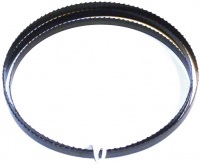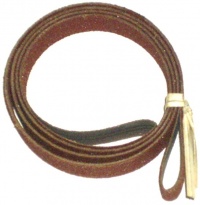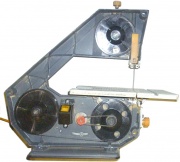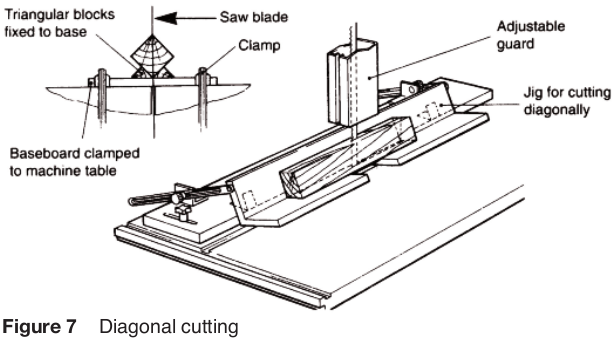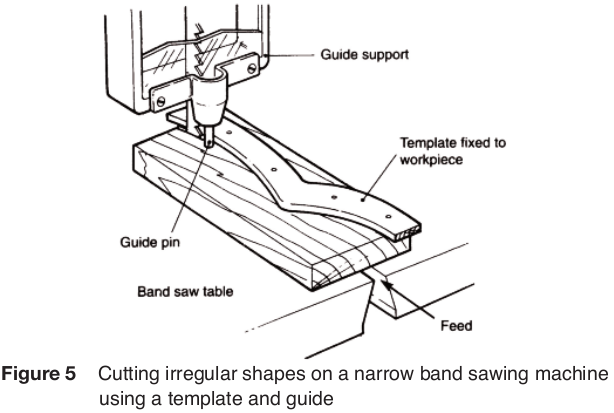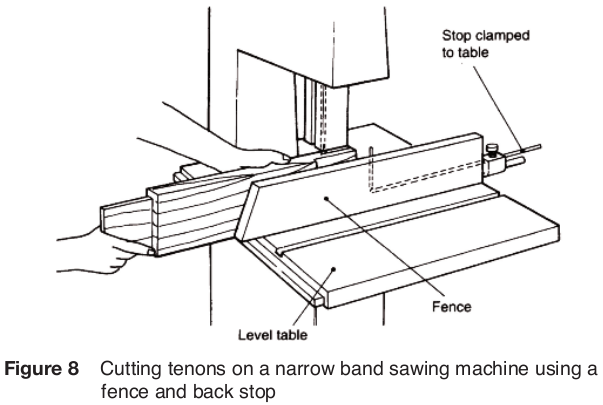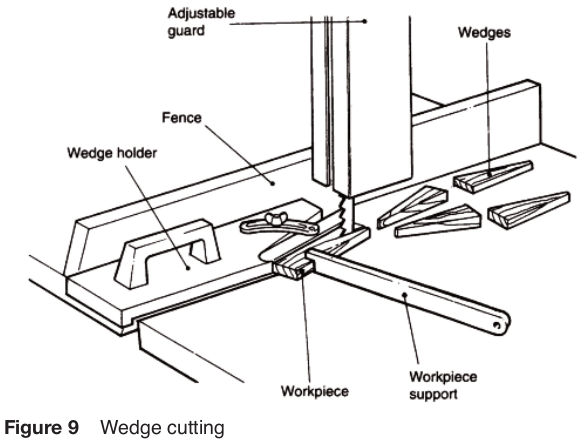Difference between revisions of "Bandsaw"
Jump to navigation
Jump to search
(→See also: link) |
(→Blades: add mouseover tips to pics) |
||
| (2 intermediate revisions by the same user not shown) | |||
| Line 8: | Line 8: | ||
==Blades== | ==Blades== | ||
| − | [[image:Bandsaw blade storage 5685-4.jpg|right|200px]] | + | [[image:Bandsaw blade storage 5685-4.jpg|right|200px|Bandsaw blade storage]] |
| − | [[image:Kerf, bandsaw v circular saw 5622-3.jpg|right|200px]] | + | [[image:Linishing belt 5785-3.jpg|right|200px|Linishing belt]] |
| + | [[image:Kerf, bandsaw v circular saw 5622-3.jpg|right|200px|Kerf: bandsaw left v circular saw right]] | ||
| − | * Blades from very coarse eg 3TPI to very fine | + | * Blades from very coarse eg 3TPI to very fine |
* Omnidirectional sawblades and sanding/linishing belts also exist. | * Omnidirectional sawblades and sanding/linishing belts also exist. | ||
| Line 76: | Line 77: | ||
* [http://www.youtube.com/watch?v=fK9m5PadmiI&feature=autoplay&list=PLF6EF6609E8BD58B9&playnext=7 Blade physics & choices] | * [http://www.youtube.com/watch?v=fK9m5PadmiI&feature=autoplay&list=PLF6EF6609E8BD58B9&playnext=7 Blade physics & choices] | ||
* [http://www.toolcenter.com/BLADE_SELECTION.html Blade choice], different info | * [http://www.toolcenter.com/BLADE_SELECTION.html Blade choice], different info | ||
| + | * [http://woodgears.ca/bandsaw/sharpening.html Sharpening bandsaw blades] | ||
| + | * [http://woodgears.ca/bandsaw/tuneup.html Cheap bandsaw tune-up] | ||
| + | |||
[[Category:Tools]] | [[Category:Tools]] | ||
Latest revision as of 01:12, 14 September 2013
- The spring steel sawblade rotates around two wheels, and passes through a cutting table.
- A few settings need to be correct to achieve a good clean straight cut
- Woodwork bandsaws can cut unhardened steel, non-ferrous metals and plastics, as long as the blade isn't too coarse
- Blades survive wood embedded with metal, assuming a blade not too coarse, but won't cut the hardened steel.
Blades
- Blades from very coarse eg 3TPI to very fine
- Omnidirectional sawblades and sanding/linishing belts also exist.
Blade width:
- Wide blades maximise feed rate and blade stiffness against bending, but increase the tendency of the blade to 'lead'
- Narrower blades allow tighter curves to be cut, but they are more vulnerable to breakage & a wandering cut, and have lower max cut rates for a given TPI, as less force can be put on them.
- 1/8" blades are used for tightly curved cuts, but are weak
Tooth patterns:
- Raker teeth are the standard type.
- Alternate set blades cut faster, but are a bit more prone to clogging
- Skip tooth blades are less prone to clogging, and are popular at low TPI counts to maintain band strength.
- Hook tooth blades dig in to the wood slighly more and cut faster
- Wavy set teeth are used on very fine blades, eg 32tpi
- Carbide tip blades cut hardened steel, cut everything faster and stay sharp much longer. But they're several times the cost. They don't use any tooth set, all teeth are in a line
- Bandknife blades are used to cut foam, leather, paper, EVA, Rubber and Carpets. They're not normally used for diy, and use continuous sharpening.
- Choosing the http://www.allbandsawblades.com/how_to.htm right type of blade]
More:
- There should be at least 3 teeth in the workpiece at all times.
- For accuracy of cutting, the set of the teeth on a bandsaw should be properly maintained. Once the set has gone, the blade tends to wander. Saw settings and blade quality also affect this.
- Saw bands with very coarse teeth can be resharpened several times in situ with a die grinder. New blades are cheap though.
- Releasing blade tension after use prolongs blade life
- Saws requiring a key to operate are available, they prevent self injury by people unable to behave themselves - as long as they don't get the key
- Blade storage: fold into 3, tie and bag. Store in a very dry place
3 Wheel bandsaw
Many small 3 wheel tabletop bandsaws were sold in the 1970s and 80s. The 3 wheel arrangement gives a small machine the cutting capacity of a larger one, to an extent. The blade bends too sharply round the 3 relatively small 6" wheels, so the blades eventually snap from metal fatigue. These were low end of the market equipment, but still serviceable once set up right.
They can produce clean straight cuts if set up right. Blades have shorter life, but are cheap to replace, and such machines are usable if space for a full size bandsaw is lacking. The 3" cut depth is limiting, it increases to 4" with the top guide removed.
None of these issues apply to the much larger 3 wheelers used in factories.
Other types of bandsaw
- Metal cutting bandsaws can have a blade cutter & welder and cutting lubrication system. The welder makes sawbands from a large reel of sawblade, and also enables closed cuts to be made.
- Meat saws have stainless steel blades and a food grade blade circuit.
- Handheld Bandsaw (picture), rather pricey as of 2011, used as a handheld metal cutoff saw, not normally used for diy
- There are also several very large bandsaw types used in factories etc
- Portable sawmills are used to process felled trees, and are often bandsaws. Some are homemade.
Techniques
See also
- Set up a bandsaw correctly
- Blade types
- More on blades
- Bandsaw Art, and how to lose a finger
- Safe working practice
- Make a bandsaw overview
- Making a bandsaw more info
- [Make a bandsaw in full detail
- Make beautiful miniature drawers
- Make gearwheels
- Blade physics & choices
- Blade choice, different info
- Sharpening bandsaw blades
- Cheap bandsaw tune-up
